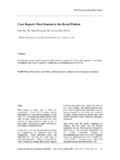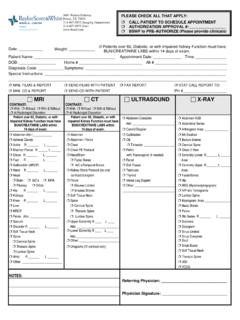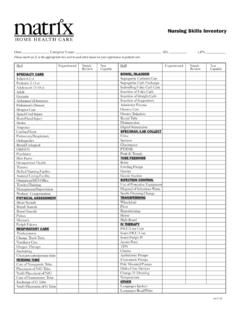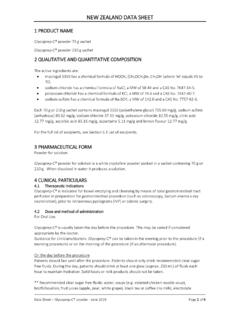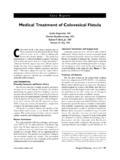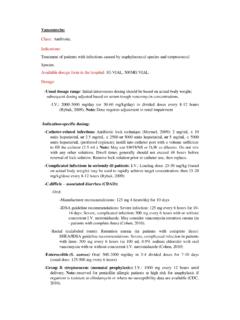Transcription of NEW ZEALAND DATA SHEET - Medsafe
1 NEW ZEALAND data SHEET ASACOL data SHEET 15 January 2018 Page 1 of 14 Emerge Health NZ Ltd 1 ASACOL Asacol 400mg enteric coated tablet Asacol 800mg enteric coated tablet Asacol w/w suppository 2 QUALITATIVE AND QUANTITATIVE COMPOSITION Active ingredient Asacol 400mg enteric coated tablet: Mesalazine (5-aminosalicylic acid, 5-ASA) 400mg in each enteric coated (gastro-resistant) tablet. Excipient with known effect: lactose, see section Asacol 800mg enteric coated tablet: Mesalazine (5-aminosalicylic acid, 5-ASA) 800mg in each enteric coated (gastro-resistant) tablet.
2 Excipient with known effect: lactose, see section Asacol w/w (500mg) suppository: Mesalazine (5-aminosalicylic acid, 5-ASA) w/w (500mg) in each suppository. For the full list of excipients, see section 3 PHARMACEUTICAL FORM Enteric coated tablets (gastro-resistant [GR]) tablets coated red/brown oblong tablets. Suppository light grey-brown, torpedo-shaped suppositories. 4 CLINICAL PARTICULARS Therapeutic indications Enteric coated tablets Ulcerative Colitis: Induction of remission of mild to moderate episodes. Maintenance of remission. Crohn's ileo-colitis: Maintenance of remission.
3 Suppositories Treatment of mild to moderate distal (proctitis and proctosigmoiditis) ulcerative colitis and maintenance of remission of distal ulcerative colitis. Dose and method of administration Enteric coated tablets Dosage for adults Ulcerative colitis Induction of remission: to (6 to 12 of the 400mg tablets, or 3 to 6 of the 800mg tablets) a day in divided doses. The dosage can be adjusted in accordance with the response to the treatment. Maintenance of remission: to (3 to 6 of the 400mg tablets, or up to 3 of the 800mg tablets) a day taken once daily or in divided doses NEW ZEALAND data SHEET ASACOL data SHEET 15 January 2018 Page 2 of 14 Emerge Health NZ Ltd Crohn's ileo-colitis Maintenance of remission: (6 of the 400mg tablets, or 3 of the 800mg tablets) in divided doses.
4 Elderly patients: Except in cases of severely impaired hepatic and renal function, the dosage stated for adults can be administered, see sections and No studies have been performed with elderly patients. Dosage for paediatrics/children There is little experience and only limited documentation for an effect in children (age 6 18 years). Children 6 years of age and older Active disease: To be determined individually, starting with 30 50mg/kg/day in divided doses. Maximum dose: 75mg/kg/day in divided doses. The total dose should not exceed Maintenance treatment: To be determined individually, starting with 15 30mg/kg/day in divided doses.
5 The total dose should not exceed It is generally recommended that half the adult dose may be given to children up to a body weight of 40kg; and the normal adult dose to those above 40kg. Administration The enteric coated tablets are for oral treatment and must be taken whole. The enteric coated tablets must not be chewed, crushed or broken under any circumstances. If possible, they should be taken before a meal with a glass of liquid . If one or several doses are omitted, the next dose should be taken as normal. Suppositories Dosage for adults Induction of remission (proctitis and proctosigmoiditis): 1 to 2 suppositories three times per day, after defecation.
6 The dosage is dependent upon the severity of the disease and it may be possible to reduce the dosage as the condition improves. In severe generalised ulcerative colitis affecting the rectum or rectosigmoid and in cases slow to respond to oral therapy one to two suppositories used morning and evening (bid) may be used as an adjunct to oral therapy. Maintenance of remission (distal ulcerative colitis): 1 suppository two times per day, after defecation. Elderly patients: Except in cases of severely impaired hepatic and renal function, the dosage stated for adults can be administered, see section and No studies have been performed with elderly patients.
7 Dosage for paediatrics/children There is little experience and only limited documentation for an effect in children. Administration Method of administration: rectal. The suppositories are for rectal use and must not be swallowed. If one or more doses have been missed, the next dose is to be taken as usual. The suppositories should be inserted deep into the anus after defecation. NEW ZEALAND data SHEET ASACOL data SHEET 15 January 2018 Page 3 of 14 Emerge Health NZ Ltd Contraindications Hypersensitivity to mesalazine or to any of the excipients listed in section Known hypersensitivity to salicylates.
8 Severe liver impairment. Severe renal impairment (GRF < 30mL per ). Children under 2 years of age. Special warnings and precautions for use Blood tests (differential blood count, liver function parameters such as ALT or AST; serum creatinine) and urinary status (dip sticks) should be determined prior to and during treatment, at the discretion of the treating physician. As a guideline, follow-up tests are recommended 14 days after commencement of treatment and then every 4 weeks for the following 12 weeks. If the findings are normal, follow-up tests should be carried out every three months.
9 If additional signs appear, these tests should be performed immediately. Renal impairment Caution should be exercised in patients with raised serum creatinine or proteinuria. The possibility of mesalazine-induced nephrotoxicity must be considered in patients developing renal impairment during treatment. Treatment with Asacol should be stopped immediately at the onset of renal impairment and patients should seek immediate medical advice. Blood dyscrasia Very rarely, serious blood dyscrasia has been reported. Treatment with Asacol should be stopped immediately if a blood dyscrasia (signs of unexplained bleeding, haematoma, purpura, anaemia, persistent fever or sore throat) is suspected or present and patients should seek immediate medical advice.
10 Hepatic impairment There have been reports of increased liver enzyme levels in patients taking preparations containing mesalazine. Caution is advised if Asacol is administered to patients with liver impairment. Cardiac hypersensitivity reactions Mesalazine-induced cardiac hypersensitivity reactions (myocarditis and pericarditis) have rarely been reported with Asacol. In cases of known, previous mesalazine-induced cardiac hypersensitivity Asacol must not be administered. Caution should be exercised in patients with previous myocarditis or pericarditis of allergic origin regardless of its cause.










